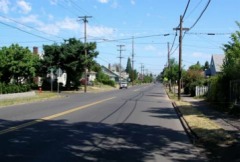
(Photo: PBOT)
This morning, Portland City Council formally accepted a $1.3 million grant for the 50s Bikeway, a project that was first identified as a priority in Portland’s 1996 Bike Master Plan. Today’s acceptance of the grant is a procedural formality (technically, it’s the signing of an Inter-Governmental Agreement between PBOT and the Oregon Department of Transportation), but it also allows PBOT to begin the final planning and outreach stages of the project.
Once complete, the 50s Bikeway will be a 6.7 mile mix of bike lanes (some exist already) and bike boulevard treatments (like medians and other traffic calming elements). The planned route begins in Northeast Portland at 57th and Thompson and goes south on 53rd Avenue to cross I-84. The route then jogs to 52nd and continues south to Woodstock Blvd.
At the route’s southern terminus, people could connect to the Springwater Trail via bike lanes on SE Woodstock or on Harney Drive (to the south). In addition to new bike lanes and other traffic calming features, the project will include improved crossings to aid people trying to cross major arterial streets like Burnside.
The project was identified in the 1996 bike plan but it wasn’t until June 2006 that the Portland Bureau of Transportation (PBOT) applied for federal funding through the Metropolitan Transportation Improvement Program. The grant was awarded a year later. PBOT project manager Rich Newlands told me this morning that they’ve been waiting for federal funds to “come live” before proceeding. According to Newlands, here’s how the project schedule plays out from here.
In about six weeks PBOT will get an official “notice to proceed.” Then, in April they’ll start a public involvement process that will run through this summer. That “project refinement phase” will likely end in late summer and Newlands says the project could start construction before the end of next year.

are being considered as a way
to calm traffic on 52nd.
(Graphic: PBOT)
According to the grant application written by PBOT bike coordinator Roger Geller, the goal for the 50s bikeway is to reduce motor vehicle speeds and volume. To do that they’ll use a “range of techniques” including bike boxes, shared-lane markings (a.k.a. sharrows), way-finding signs, and so on. Here’s an excerpt from the grant application:
“On the bicycle boulevard segments of this project, we will use a full range of techniques designed to create world-class, low-traffic volume, low-traffic speed bicycle boulevards… We will fully investigate conditions throughout these corridors and add additional traffic calming, as needed in order to bring speeds as low as we allowably can.”
Also according to the grant application, the most significant design element of the bike boulevard portion of the project will be the creation of “chicanes to create queuing conditions for motorists at alternating intersections, while allowing unimpeded passage for cyclists.” You can see a drawing of that design on the right.
PBOT says chicane treatment “…. will secure priority for bicycles on the boulevard segments of the street, dramatically slow traffic, and divert some existing traffic, without denying access to the street for motorists.”
Newlands says all these design ideas will be put in front of the public for feedback during the outreach process. Stay tuned for ways you can chime in.

